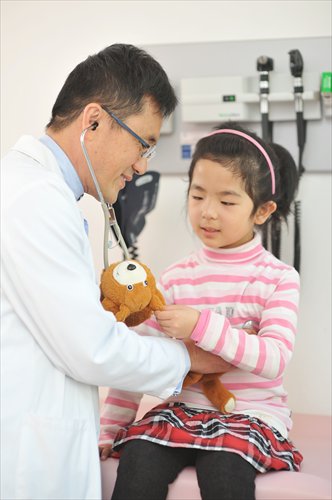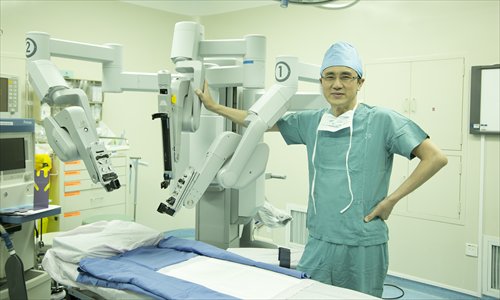BJU leads in pediatric robotic surgery

Wei Cheng treats a child in the hospital. Photo: Courtesy of BJU
Advanced robotic technology is playing an increasingly important role in complex medical operations. Among the advanced technologies, one robotic surgical instrument, the da Vinci Surgical System, stands out above the rest. Made by the US-based company Intuitive Surgical and approved by American Food and Drug Administration (FDA), the da Vinci allows surgeons to do minimally invasive, complex surgeries with accuracy, precision, and above all, safety.
The Beijing United Family Hospital and Clinics (BJU) is one of the very few domestic hospitals that has this world-class and sought-after technology. The hospital performed 100 operations within the first year of acquiring the surgical system. The most common operations that use the robotic technology include urological operations, especially pediatric urological operations - making BJU one of the early pioneers in pediatric robotic surgery in China.
Pediatric surgeon Wei Cheng is one of the first doctors to work with the da Vinci Surgical System at BJU. He shared with the Global Times (GT) his knowledge about the system.

Wei Cheng with the da Vinci Surgical System Photo: Courtesy of BJU
GT: What are the requirements for a surgeon who operates the da Vinci Surgical System at BJU?
Cheng: The da Vinci surgical robot is one of the most sophisticated surgical instruments available. For the safety of patients, strict and mandatory training is required before any surgeon is allowed to operate the machine. The process consists of five steps. First, the robotic console surgeons are selected. Candidates are selected based on their experience and ability to operate independently. Previous laparoscopic surgery experience is also a must.
The selected candidates are then required to undergo an Internet-based training course on the robot, its structure, specificities, control, and safety measures, before sitting a three-part exam. Only surgeons who pass the exam can progress to the next stage.
After the exam comes the practical training. Surgeons are then allowed to practice various surgical skills on a da Vinci simulator, learning skills like suturing, knotting, controlling bleeding, and so on. On mastering these skills, the surgeons will then progress to the robotic teaching laboratory, which is located at the Chinese University of Hong Kong. In the laboratory, the surgeons learn to operate on animals in a team environment. The team consists of a chief surgeon, a surgeon assistant and a surgical nurse. Only when the team is proficient with the robot will they be awarded a permit to operate.
After they received their permit, the surgical team must then perform their first three operations on real patients under the supervision of robotic experts. A final certificate is awarded after an accumulation of at least 20 cases.
GT: What are some of the challenges in operating such a device?
Cheng: Compared with conventional laparoscopic surgery, the flexibility of the robotic surgical instrument makes the operation more intuitive, precise and safe. The real challenge for the surgical team is the process of familiarization with the robot and its functionality.
GT: The da Vinci system has been criticized for its high cost and some issues with its performance. What's your view?
Cheng: It is healthy to raise questions about new technologies, as this is the only way to progress. The da Vinci robot is a very sophisticated system, and it is, without a doubt, an expensive machine. However, one needs to balance the benefit of improved precision and safety against the cost. I believe, the surgical robot is currently in its embryonic stage. With further development, the cost will come down, and the functionality will become even more sophisticated. A parallel analogy might be mobile phones. When they first appeared, they were large, very expensive, and few people had access to them. Mobile phones have since morphed into the ubiquitous smart phones of today; they are not only far more versatile but have also become an indispensable tool in society. As the technology improves, so will people's expectations. I believe this will also apply to healthcare. The performance of the robot in my experience has been excellent.
GT: If a problem occurs, is there a possibility for hands-on assessment to correct errors relating to the device or doctor error?
Cheng: It is not difficult to identify the cause of complications. The rate of complication in robotic surgery is comparable to that of laparoscopic and open surgeries. In a large study conducted by eight surgical centers in the US, an examination of complication rates from 880 urological operations on children, found that most of the complications were related to human error. There was only one case due to robotic mechanical failure.
Global Times